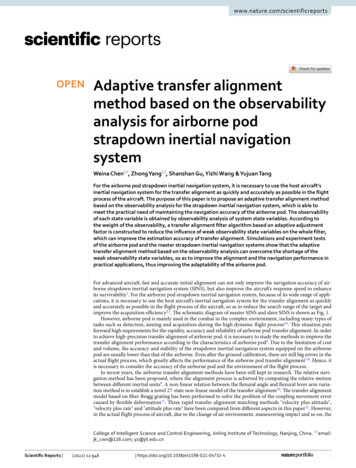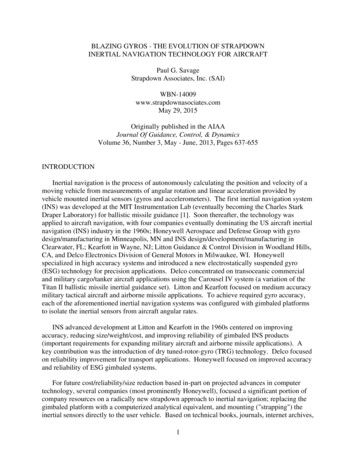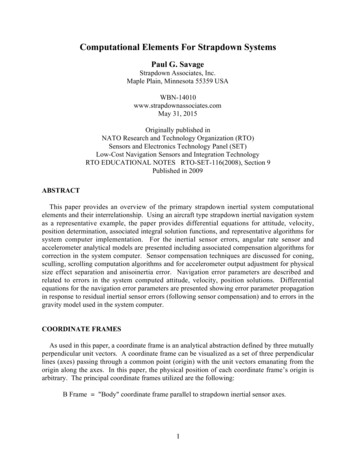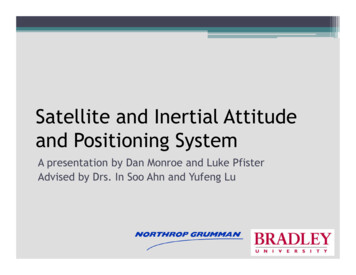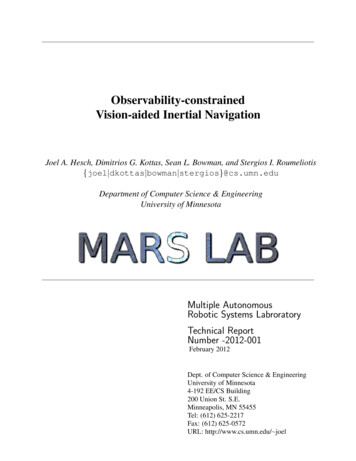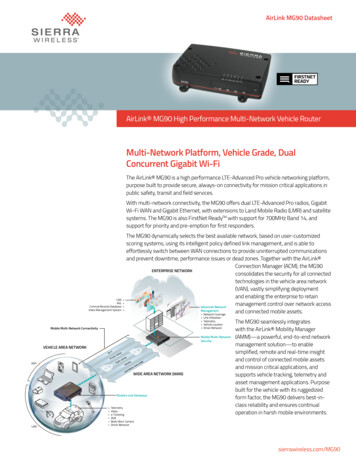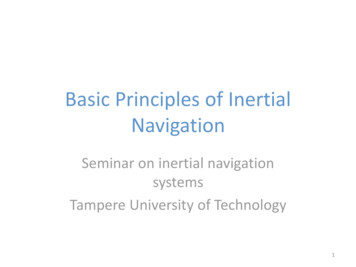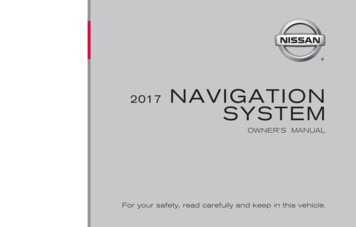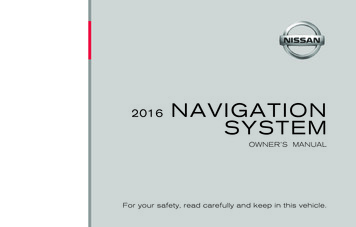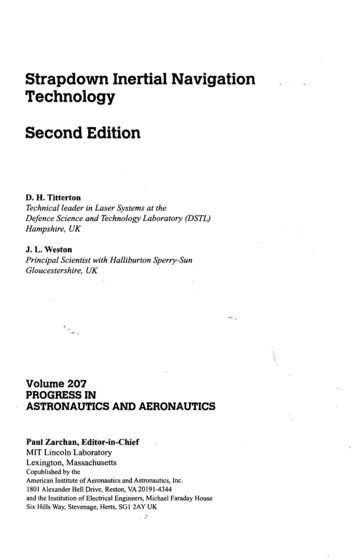
Transcription
Strapdown Inertial NavigationTechnologySecond EditionD. H. TittertonTechnical leader in Laser Systems at theDefence Science and Technology Laboratory (DSTL)Hampshire, UKJ. L. WestonPrincipal Scientist with Halliburton Sperry-SunGloucestershire, UKVolume 207PROGRESS INASTRONAUTICS AND AERONAUTICSPaul Zarchan, Editor-in-ChiefMIT Lincoln LaboratoryLexington, MassachusettsCopublished by theAmerican Institute of Aeronautics and Astronautics, Inc.1801 Alexander Bell Drive, Reston, VA 20191-4344and the Institution of Electrical Engineers, Michael Faraday HouseSix Hills Way, Stevenage, Herts, SGI 2AY UK
al navigation1.3Strapdown technology1.4Layout of the book2Fundamental principles and historical developments ofinertial navigation2.1Basic concepts2.2Summary2.3Historical developments'" 2.4 1 -The modern-day inertial navigation system2.5Trends in inertial sensor development3Basic principles of strapdown inertial navigation systems\3.1Introduction3.2A simple two-dimensional strapdown navigation system3.3Reference frames3.4Three-dimensional strapdown navigation system - generalanalysis3.4.1Navigation with respect to a fixed frame3.4.2Navigation with respect to a rotating frame3.4.3The choice of reference frame3.4.4Resolution of accelerometer measurements3.4.5System example3.5Strapdown system mechanisations3.5.1Inertial frame mechanisation3.5.2Earth frame mechanisation3.5.3Local geographic navigation frame 525262831
viContents3.63.73.5.4Wander azimuth navigation frame mechanisation3.5.5Summary of strapdown system mechanisationsStrapdown attitude representations3.6.1Introductory remarks3.6.2Direction cosine matrix3.6.3Euler angles3.6.4Quaternions3.6.5Relationships between direction cosines, Euler anglesand quaternionsDetailed navigation equations3.7.1Navigation equations expressed incomponent form3.7.2The shape of the Earth3.7.3Datum reference models3.7.4Variation of gravitational attraction over th(1hGyroscope technology 14.1Introduction4.2Conventional sensors4.2.1Introduction4.2.2Fundamental principles4.2.3Components of a mechanical gyroscope4.2.4Sensor errors4.2.5Rate-integrating gyroscope4.2.6Dynamically tuned gyroscope4.2.7Flex gyroscope4.3Rate sensors4.3.1Dual-axis rate transducer (DART)4.3.2Magnetohydrodynamic sensor4.4Vibratory gyroscopes4.4.1Introduction4.4.2Vibrating wine glass sensor4.4.3Hemispherical resonator gyroscope4.4.4Vibrating disc sensor4.4.5Tuning fork sensor4.4.6Quartz rate sensor4.4.7Silicon sensor4.4.8Vibrating wire rate sensor4.4.9General characteristics of vibratory sensors4.5Cryogenic devices4.5.1Nuclear magnetic resonance gyroscopeSARDIN4.5.24.6Electrostatically suspended gyroscope4.7Other devices for sensing angular motion4.7.1Fluidic (flueric) 78184848688888991939494969899100100103103105105
Contents4.7.24.7.3Fluxgate magnetometersThe transmission line gyroscopevn107112Gyroscope technology 25.1Optical sensors5.1.1Introduction5.1.2Fundamental principles5.1.3Ring laser gyroscope5.1.4Three-axis ring laser gyroscopeconfiguration5.1.5Fibre optic gyroscope5.1.6Photonic crystal optical fibre gyroscope5.1.7Fibre optic ring resonator gyroscope5.1.8Ring resonator gyroscope5.1.9Integrated optical gyroscope5.2Cold atom sensors5.2.1Introduction5.2.2Rotation sensing5.2.3Measurement of acceleration5.2.4Gravity gradiometer5.3Summary of gyroscope technology115115115116118Accelerometer and multi-sensor technologyIntroduction6.16.2The measurement of translational motion6.3Mechanical sensors6.3.1Introduction. .6.3.2Principles of operation6.3.3Sensor errors6.3.4Force-feedback pendulous accelerometer6.3.5Pendulous accelerometer hinge elements6.3.6Two-axes force-feedback accelerometer6.3.7Open-loop accelerometers6.4Solid-state accelerometers6.4.1Vibratory devices6.4.2Surface acoustic wave accelerometer6.4.3Silicon sensors6.4.4Fibre optic accelerometer6.4.5Optical accelerometers6.4.6 u Other acceleration sensorsMulti-functional sensors6.5Introduction6.5.16.5.2Rotating devices6.5.3Vibratory multi-sensor6.5.4Mass unbalanced 174174174178179
viiiContents6.66.76.878Angular accelerometers6.6.1Liquid rotor angular accelerometer6.6.2Gas rotor angular accelerometerInclinometersSummary of accelerometer and multi-sensor technologyMEMS inertial sensors7.1Introduction7.2Silicon processing7.3MEMS gyroscope technology7.3.1Introduction7.3.2Tuning fork MEMS gyroscopes'7.3.3Resonant ring MEMS gyroscopes7.4MEMS accelerometer technology7.4.1Introduction7.4.2Pendulous mass MEMS accelerometers7.4.3Resonant MEMS accelerometers7.4.4Tunnelling MEMS accelerometers7.4.5Electrostatically levitated MEMSaccelerometers7.4.6Dithered accelerometersMOEMS7.5Multi-axis/rotating structures7.67.7MEMS based inertial measurement units7.7.1Silicon IMU7.7.2Quartz IMUSystem integration7.8Summary7.9Testing, calibration and compensation8.1IntroductionTesting philosophy8.2Test equipment8.38.4Data-logging equipment8.5Gyroscope testing8.5.1Stability tests - multi-position tests8.5.2Rate transfer tests8.5.3Thermal tests8.5.4Oscillating rate table tests8.5.5Magnetic sensitivity tests8.5.6Centrifuge tests8.5.7Shock tests8.5.8 c Vibration tests8.5.9Combination tests8.5.10 Aeeine and storaee 3, 223226231233233235237238241242
Contents8.6Accelerometer testing8.6.1Multi-position tests8.6.2Long-term stability8.6.3Thermal tests8.6.4Magnetic sensitivity tests8.6.5Centrifuge tests8.6.6Shock tests8.6.7Vibration tests8.6.8Combination tests8.6.9Ageing and storage testsCalibration and error compensation8.7.1Introduction8.7.2Gyroscope error compensation8.7.3Accelerometer error compensation8.7.4Further comments on error compensationTesting of inertial navigation systemsHardware in the loop 255259Strapdown system technology9.1Introduction9.2The components of a strapdown navigation system9.3The instrument cluster9.3.1Orthogonal sensor configurations9.3.2Skewed sensor configurations9.3.3A skewed sensor configuration using dual-axisgyroscopes9.3.4Redundant sensor configurations- 9.4-. Instrument electronics9.5The attitude computerThe navigation computer9.69.7Power conditioning\Anti-vibration mounts9.8Concluding remarks9.9263263263264264265Inertial navigation system alignment10.1 Introduction10.2 Basic principles10.2.1 Alignment on a fixed platform10.2.2 Alignment on a moving platform10.3 Alignment on the ground10.3.1 Introduction10.3.2 Ground alignment methods10.3.3 Northfinding techniques10.4 In-flight alignment10.4.1 88.990ix266268269271272274274274
x11Contents10.4.2 Sources of error10.4.3 In-flight alignment methods10.5 Alignment at sea10.5.1 Introduction10.5.2 Sources of error10.5.3 Shipboard alignment methods289289300300.300301Strapdown navigation system computation11.1 Introduction11.2 Attitude computation11.2.1 Direction cosine algorithms11.2.2 Rotation angle computation11.2.3 Rotation vector compensation11.2.4 Body and navigation frame rotations11.2.5 Quaternion algorithms11.2.6 Orthogonalisation and normalisationalgorithms11.2.7 The choice of attitude representation11.3 Acceleration vector transformation algorithm11.3.1 Acceleration vector transformation usingdirection cosines11.3.2 Rotation correction11.3.3 Dynamic correction11.3.4 Acceleration vector transformation usingquaternions11.4 Navigation algorithm11.5 Summary30930931012 Generalised system performance analysis12.1 Introduction12.2 Propagation of errors in a two-dimensional strapdownnavigation system12.2.1 Navigation in a non-rotating reference frame12.2.2 Navigation in a rotating reference frame12.2.3 The Schuler pendulum12.2.4 Propagation of errors in a Schuler tuned system12.2.5 Discussion of results12.3 General error equations12.3.1 Derivation of error equations12.3.2 Discussion12.4 Analytical assessment12.4.1 Single channel error model12.4.2 Derivation of single channel error propagationequations12.4.3 Single-channel error propagation 335335336336337339. 340341342342346350350352358
Contentsxi12.5 Assessment by simulation12.5.1 Introductory remarks12.5.2 Error modelling12.5.3 Simulation techniques12.6 Motion dependence of strapdown system performance12.6.1 Manoeuvre-dependent error terms12.6.2 Vibration dependent error terms12.7 Summary36036036136336536636837413 Integrated navigation systems13.1 Introduction13.2 Basic principles13.3 External navigation aids 13.3.1 Radio navigation aids13.3.2 Satellite navigation aids13.3.3 Star trackers13.3.4 Surface radar trackers13.4 On-board measurements13.4.1 Doppler radar13.4.2 Magnetic measurements13.4.3 Altimeters13.4.4 Terrain referenced navigation13.4.5 Scene matching13.4.6 Continuous visual navigation13.5 System integration13.6 Application of Kalman filtering to aided inertial navigationsystems- '.13.6.1Introduction13.6.2 Design example of aiding13.7 INS-GPS integration.13.7.1 Uncoupled systems' 13.7.2 Loosely coupled integration13.7.3 Tightly coupled integration13.7.4 Deep integration13.7.5 Concluding remarks13.7.6 INS aiding of GPS signal tracking13.8 Multi-sensor integrated navigation13.9 9940114 Design example14.1 Introduction14.2 Background to the requirement14.3 The navigation system requirement14.3.1 Navigation data required14.3.2 Operating and storage 415416416417418
xiiContents14.3.3 Performance14.3.4 System reaction time14.3.5 Physical characteristics14.4 Why choose strapdown inertial navigation?14.5 Navigation system design and analysis process14.5.1 Introduction14.5.2 Choice of system mechanisation14.5.3 Error budget calculations14.5.4 System alignment14.5.5 Choice of inertial instruments14.5.6 Computational requirements14.5.7 Electrical and mechanical interfaces14.6 Testing, calibration and compensation requirements14.7 Performance enhancement by aiding14.8 Concluding remarks15 Alternative applications of IN sensors and systems15.1 Introduction15.2 Borehole surveying15.2.1 Introduction15.2.2 Historical background15.2.3 Inertial survey system15.2.4 System design requirements15.2.5 System design issues15.2.6 System calibration and test15.2.7 Concluding remarks15.3 Ship's inertial navigation systems (SINS)15.3.1 NATO SINS15.4 Vehicle stabilisation and control15.4.1 Autopilots15.4.2 Passive missile roll control (rollerons)15.4.3 Intelligent transport systems - automotiveapplications15.4.4 Intelligent transport systems - trains15.4.5 Personal transport15.5 Equipment stabilisation15.5.1 Aero-flexure compensation15.5.2 Laser beam director15.5.3 Laser radar15.5.4 Seeker-head stabilisation15.5.5 Sightline stabilisation15.5.6 Relative angular alignment15.5.7 Calibration and measurement15.6 Geodetic and geophysical measurements and observation offundamental physical 64467467469470475479482487491493495
Contents15.7Other applications15.7.1 Moving-map displays15.7.2 Safety and arming units15.7.3 Aircraft ejection seats15.7.4 Agricultural survey15.7.5 Artillery pointing15.7.6 Other unusual applications15.8 Concluding remarksxiii499499502503505505507508Appendix AKalman filtering511Appendix BInertial navigation system error budgets519Appendix CInertial system configurations523Appendix DComparison of GPS and GLONASS satellitenavigation systems529List of symbols535Glossary of principal terms539Index549
1.1 Navigation 1 1.2 Inertial navigation 2 1.3 Strapdown technology 3 1.4 Layout of the book 4 2 Fundamental principles and historical developments of inertial navigation 7 2.1 Basic concepts 7 2.2 Summary 11 2.3 Historical developments '" 11 2.4 1-The modern-day inertial navigation system 14 2.5 Trends in inertial sensor development 15
